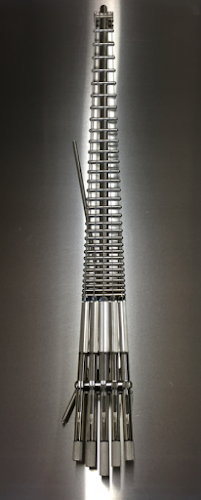After sanding and polishing, the neck blank looks really good:
I made the bridge out of solid brass. It's not really easy to "machine" an entire brass bridge without machines. I just cut the 10 pieces on the band-saw, sanded them to size and shape on the belt sander, and assembled with M3 socket screws.
Next, I made the tuners using long M3 screws.
Last but not least in terms of difficulty, I made a brass anchor block for the strings to attach to the end of the neck. I broke a drill bit deep in the block on one of the first holes. I found a solution to remove it on the internet, which is apparently an old trick of watch and clockmakers. Dropping the brass block in a very hot saturated solution of alum, and let it bubble until the steel is completely dissolved:
I put the whole thing together as a mock-up to see how it would work. The two humbucker soap bar pickups will need to be embedded deep into the "neck", and it will have to be extended 6" or so to fit the pots and jack assembly. In order for the bridge to fit and the tuners to do their job pulling the strings down on the bridge at a sufficient angle, it will have to be bent :
The cut is so deep there will be just an inch or so of aluminum left, so it will need to be re-enforced somehow at the bent. The best solution seems to be if it can be found, to use a foot long section of 1/4"' thick 2 1/2" aluminum pipe that will wrap tightly around the neck and be attached to it with two large bolts on each side of the bent. It would make the "body of the bass 1/2" wider, just about enough to accommodate the bridge, tuner, and pickup full width:









































